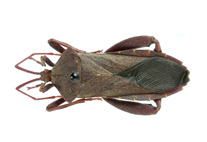Abstract
Leptohyphes cornutus Allen from Brazil (Santa Catarina) and Misiones, Argentina is re-studied from new material and newly diagnosed as follows: tubercles on head (two pairs), pronotum (two pairs, anterior pair very small), and mesonotum (two pairs), abdominal terga without paired tubercles, nor remnants of them; fore femur length/maximum width, 1.4–1.8; tarsal claws denticulation 4–11+1; hind wing pads present in females; gill formula 3/10/8/8/5. Three new species are described from the nymphal stage: 1) Leptohyphes airuoca sp. nov. from Minas Gerais and Rio de Janeiro (Brazil) characterized by: i) two paired tubercles on head, two pairs on pronotum, and one pair on mesonotum, abdominal terga VI–IX with single medial tubercle projecting from hind margin; ii) fore femur length/maximum width, 1.7–2.0; iii) tarsal claws denticulation 4+0; iv) hind wing pads absent in female; v) gill formula 3/9/9/7/6. 2) Leptohyphes cornutillus sp. nov. from Espirito Santo (Brazil), with: i) paired tubercles on head (two pairs), pronotum (two pairs, anterior pair very small), and mesonotum (three pairs), abdominal terga with remnants of paired tubercles on hind margin (blunt and short undulations in dorsal view); ii) fore femur length/maximum width, 2.1–2.3; iii) tarsal claws denticulation 6+1; iv) hind wing pads present in females; v) gill formula 3/11/9/9/6. And 3) Leptohyphes nebulosus sp. nov. from Espirito Santo (Brazil), with: i) two paired tubercles on head, one pair on pronotum, and one pair on mesonotum, abdominal terga VI–VII with paired submedian tubercles on hind margin; ii) fore femur length/maximum width, 1.6; iii) tarsal claws denticulation 5+1; iv) hind wing pads present in females; v) gill formula 3/9/9/9/6.

